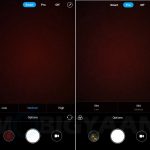When we talk about Xiaomi, the first thing that comes to our mind is their lineup of smartphones in the budget segment that come with really decent hardware as compared to the competition. Xiaomi has launched smartphones like the Redmi 4 and the Redmi Note 4 in India this year that have been immensely popular and successful in the country. Last month, the company also launched the Mi MIX 2 in India and proved that it can produce beautiful and powerful smartphones as well. That said, earlier this month, Xiaomi forayed into the selfie-centric smartphone market with the launch of Xiaomi Redmi Y1 that comes with typical Xiaomi hardware and pricing, but, with the target audience being those who like taking a lot of selfies. So, how well does this new smartphone fare? Well, we find that out with this Xiaomi Redmi Y1 review.
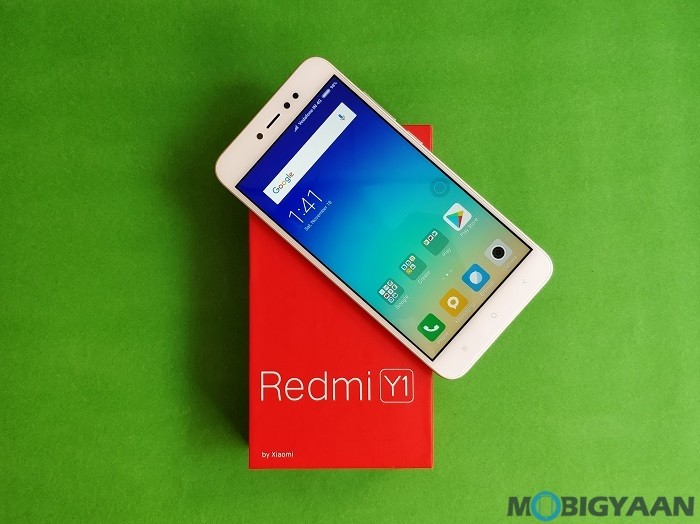
In box contents
- Xiaomi Redmi Y1
- Charger (5V/2A)
- USB Cable
- SIM Tray Ejector
- Safety Manual
- User Guide
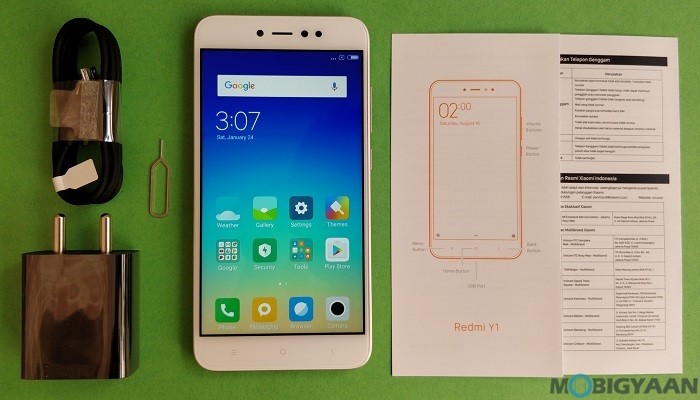
Xiaomi Redmi Y1 Specifications
- CPU: 1.4 Ghz Snapdragon 435 octa-core processor
- RAM: 3/4 GB
- GPU: Adreno 505
- Operating System: MIUI 9 based on Android 7.1.2 Nougat
- Display: 5.5-inch HD (1280 x 720 pixels) IPS display with 2.5D curved glass and Gorilla Glass protection
- Rear Camera: 13 MP with PDAF, f/2.2 aperture and LED flash
- Front Camera: 16 MP with f/2.0 aperture, 76.4° wide-angle lens, Beauty Mode and LED selfie flash
- Internal Storage: 32 (with 3 GB RAM), 64 GB (with 4 GB RAM)
- External Storage: Expandable up to 128 GB via microSD card (dedicated slot)
- SIM: Dual SIM (Nano + Nano)
- Connectivity: 4G VoLTE, GPS, Bluetooth 4..2, Wi-Fi 802.11 b/g/n, 3.5 mm headphone jack, micro USB
- Other: Fingerprint Scanner, IR Blaster
- Colors: Dark Grey, Gold
- Battery: 3080 mAh
Design
The Xiaomi Redmi Y1 has a design similar to that of the Redmi 4. However, while the Redmi 4 sports a 5-inch display, the Redmi Y1 comes with a larger 5.5-inch display. The display has a resolution of 1280 x 720 pixels along with 2.5D curved glass atop. It also comes with Gorilla Glass that adds an extra layer of protection to the screen against scratches.
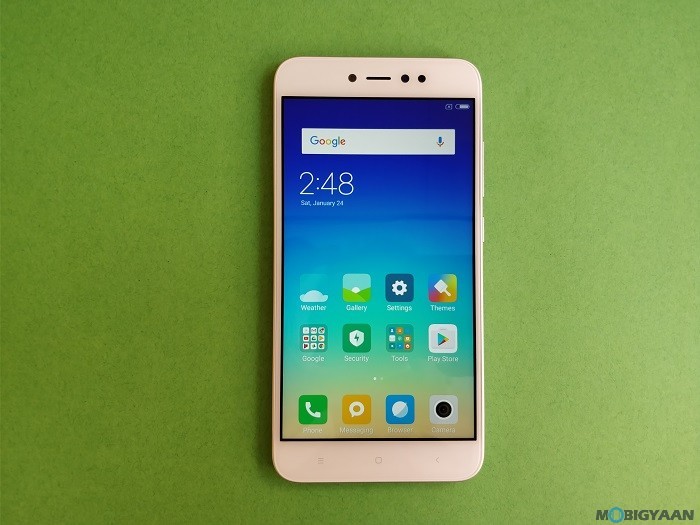
Above this 5.5-inch display is the earpiece which is flanked by proximity sensor and 16 MP selfie camera. The selfie camera is also accompanied by flash to help you take brighter selfies in low-light conditions.
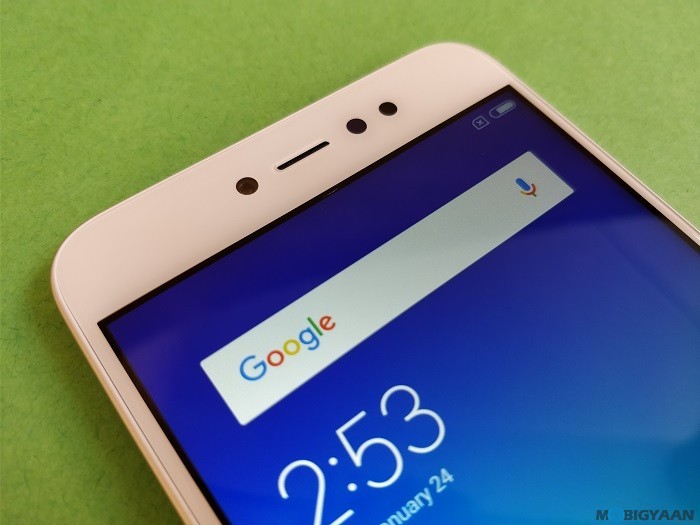
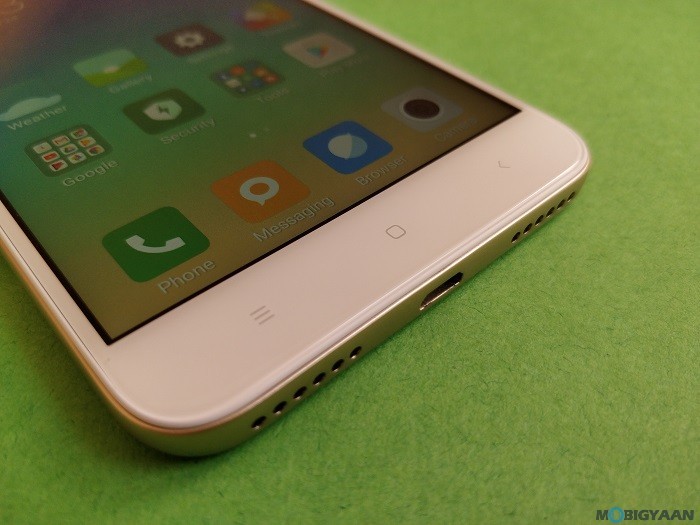
Below the display are the capacitive navigation keys. However, they are painted grey and aren’t back-lit.
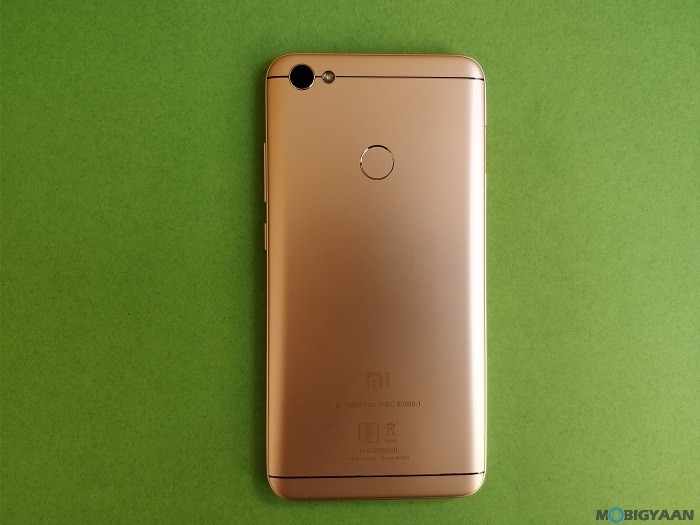
The back of the Redmi Y1 is made out of plastic, but, it has a metallic finish which makes it look good. Moreover, it isn’t soft plastic, which means you don’t have to worry much about getting scratches on it.
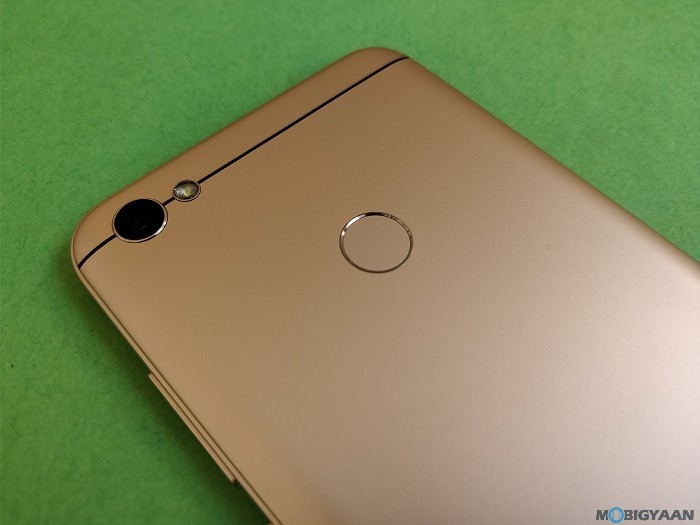
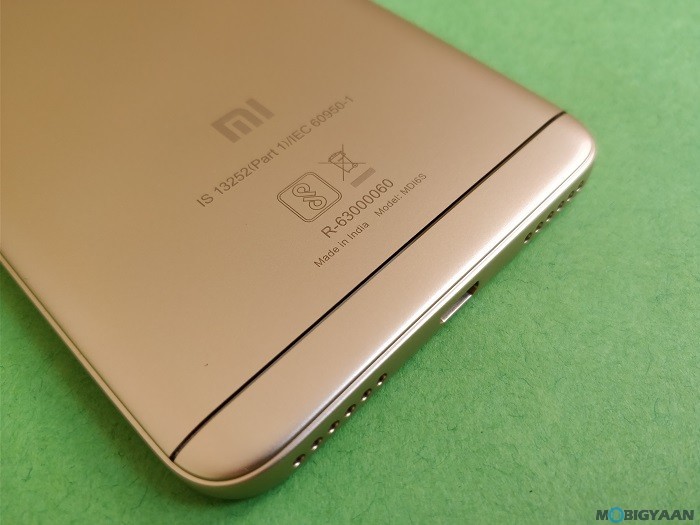
At top-left corner of the back, you can see the 13 MP primary camera along with LED flash. The back of the Redmi Y1 is also home to fingerprint scanner which provides additional security to your smartphone. Further down below, you can see the Mi logo with ‘Made in India’ written in small fonts.
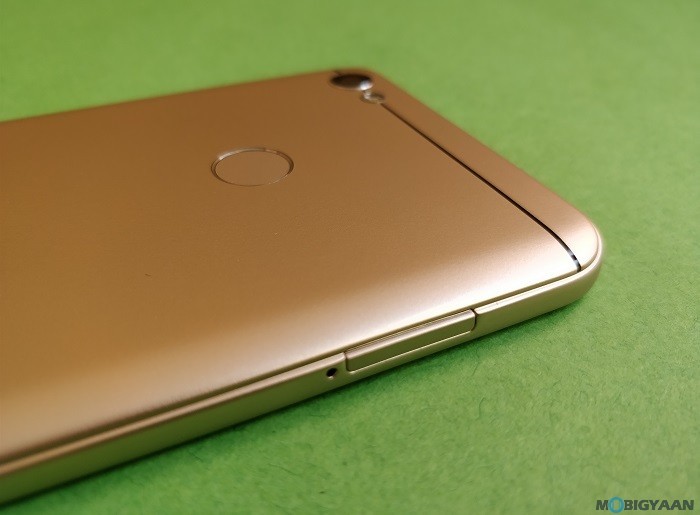
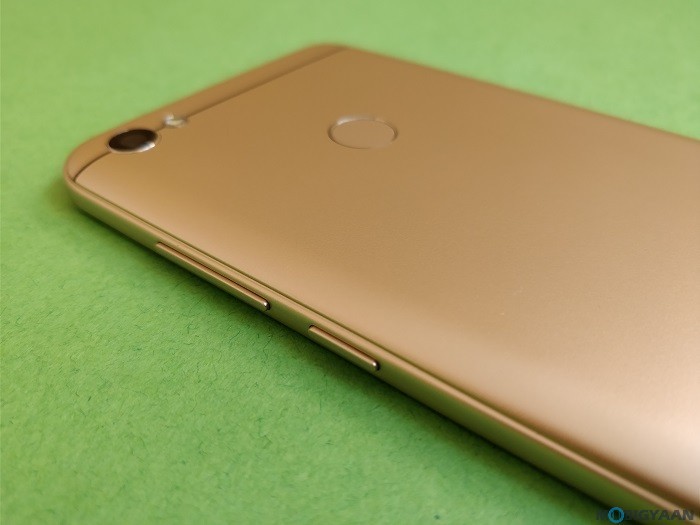
While the back of the Redmi Y1 is made out of plastic, its frames are made out of aluminium alloy. The phone has volume rocker and power button to its right which are built well and provide nice feedback. And, to the left are the slots for SIM card and microSD card.
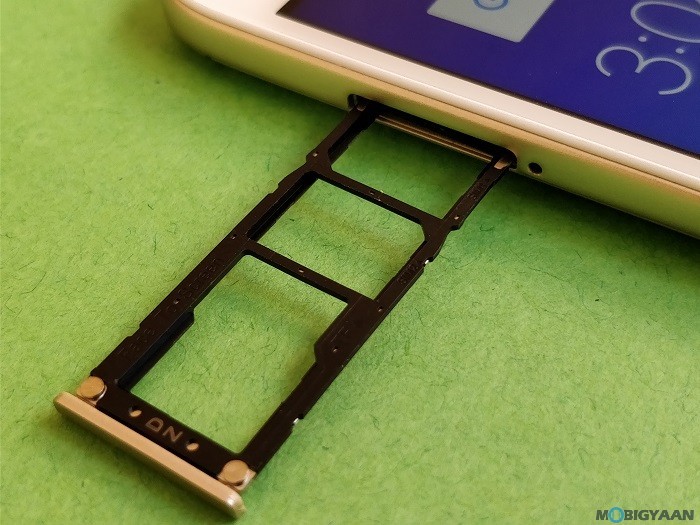
However, unlike other smartphones that come with hybrid SIM slots, the one on the Redmi Y1 comes with a separate slot for microSD card. Well, what that means is that you can insert two nano SIM cards inside this phone while also being able to insert a microSD card to expand the storage.
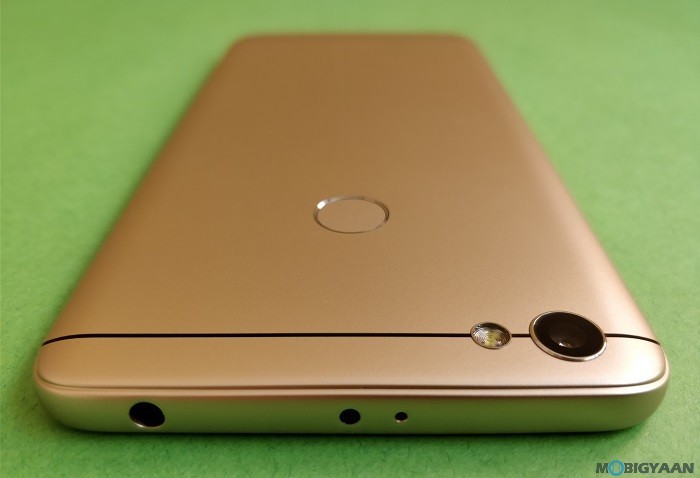
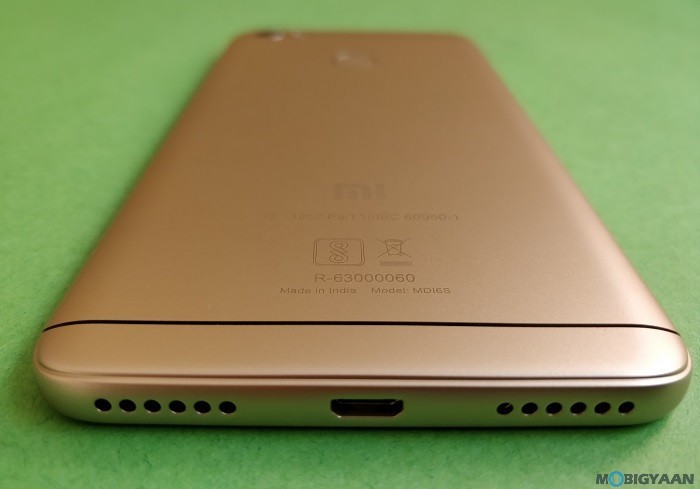
Having said that, the Xiaomi Redmi Y1 has a 3.5 mm headphone jack up top along with secondary mic and IR blaster. And, at the bottom is the micro USB port that’s flanked by two grilles – one houses primary mic with the other housing the speaker.
This kind of speaker placement ensures that the sound coming off wouldn’t get muffled when the phone is kept on a flat surface, however, it does get blocked sometimes when you are watching videos or playing games.
All in all, the Xiaomi Redmi Y1 has a nice design and sturdy build, but it’s not anything new. Even with a 5.5-inch display, it’s pretty comfortable to hold, and, the fingerprint scanner at the back is also easily reachable.
Display
The Xiaomi Redmi Y1 comes with a 5.5-inch IPS display with a resolution of 1280 x 720 pixels and a pixel density of around 270 ppi. It has 2.5D curved glass atop and comes with Gorilla Glass for protection against scratches.

The display on the Redmi Y1 is decent. The colors were good and so were the viewing angles. We didn’t have much problem viewing the contents on the screen in sunlight, however, we did have some tough time viewing the screen under direct sunlight.
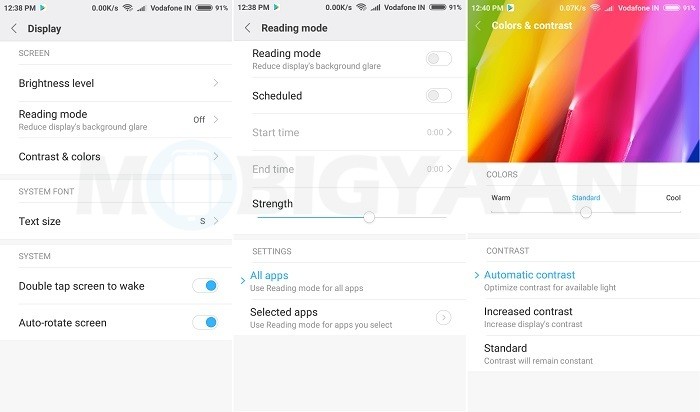
That said that, the phone didn’t adjust to surrounding lighting quickly. What we mean is that the auto-brightness feature didn’t work perfectly, and most of the time, we had to adjust the brightness of the display manually. Moreover, the display also has a black border around the screen, which though not much of a problem, might be annoying for some.
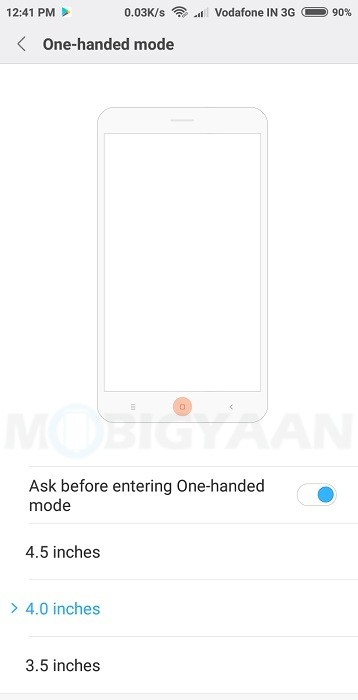
Having said that, the Xiaomi Redmi Y1 comes with a Reading Mode which helps reduce strain to your eyes while using the phone at night by adding a yellowish layer to the screen. You can turn on the Reading Mode manually, can schedule it to to turn on and off at a specific time, or, can turn it on when specific apps are opened.
Furthermore, if you have smaller hands, the Redmi Y1 also comes with one-handed mode which lets you shrink the size of the on-screen contents to match the screen size of 3.5-inch, 4-inch or 4.5-inch display.
Fingerprint Scanner
The Xiaomi Redmi Y1 comes with a fingerprint scanner at the back for additional security.

It’s placed well at the back which makes it easier to reach. It’s fast and accurate. We didn’t have any issues unlocking the smartphone using the fingerprint scanner.
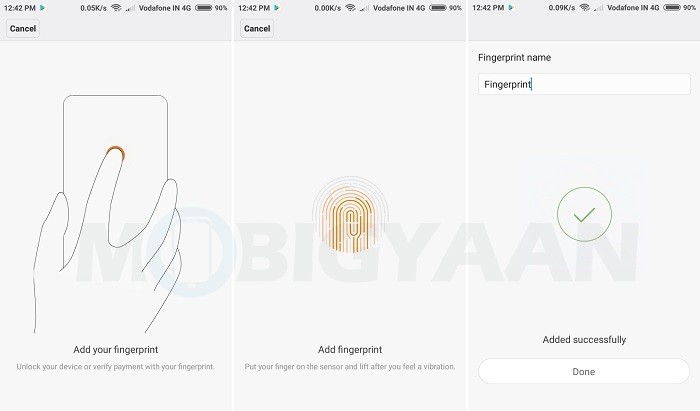
You can enable the fingerprint unlock on the Redmi Y1 by going to the Settings > Lock screen & password > Manage fingerprints menu.
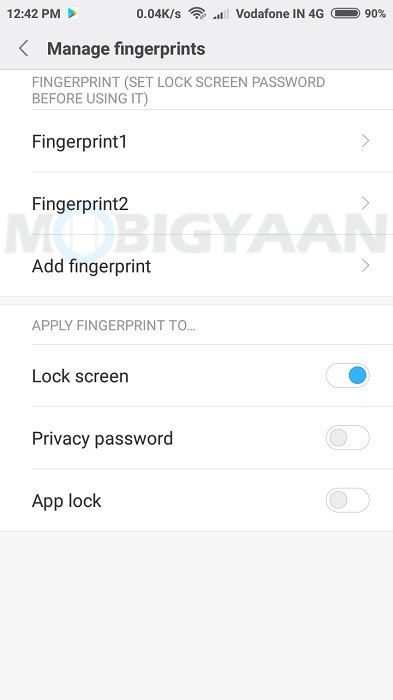
Moreover, the fingerprint scanner can not only be used to unlock your smartphone, but, can also be used to secure your privacy password and lock apps. Besides, you can also use it as a shutter button to capture photos, especially selfies.
Performance
The Xiaomi Redmi Y1 comes with Snapdragon 435 SoC under the hood which consists of eight Cortex-A53 processors that are clocked up to 1.4 GHz. The Snapdragon 435 SoC on the Redmi Y1 is paired with 3 or 4 GB RAM.
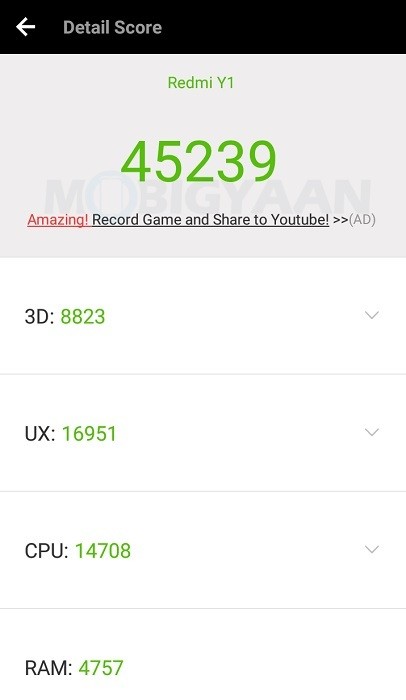
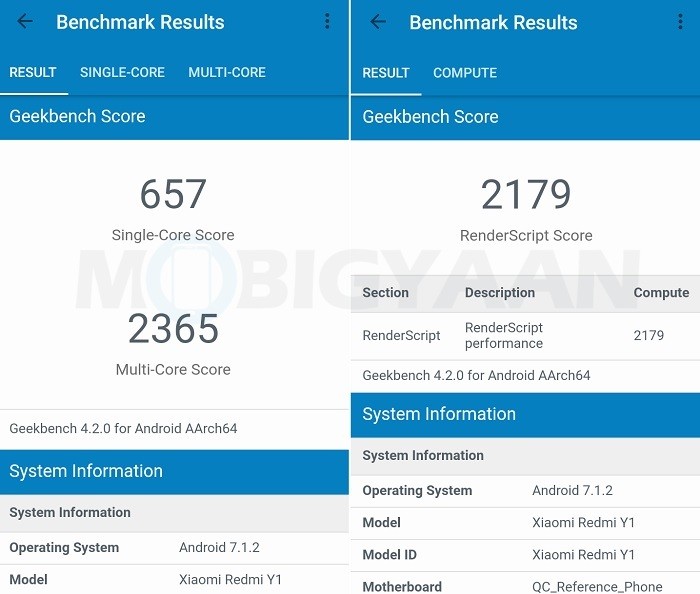
The 3 GB RAM variant of the Redmi Y1 comes with 32 GB of internal storage whereas the 4 GB RAM variant comes with 64 GB of storage on board. The review unit we got has 3 GB of RAM though.
In our AnTuTu benchmark test, the Redmi Y1 scored 45,239 points. In our Geekbench 4 test, the Redmi Y1 came up with a score of 657 and 2365 points in single and multi-core tests. However, in Geekbench 4’s Compute test, the Y1 scored 2179 points. Here are the full stats of Geekbench 4 CPU and Compute test of the Redmi Y1 if you are interested.
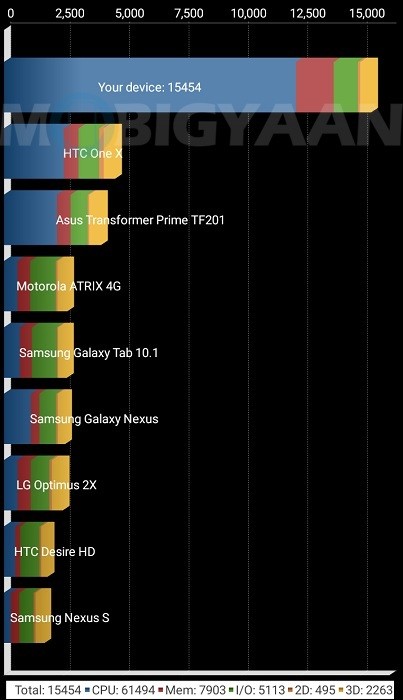
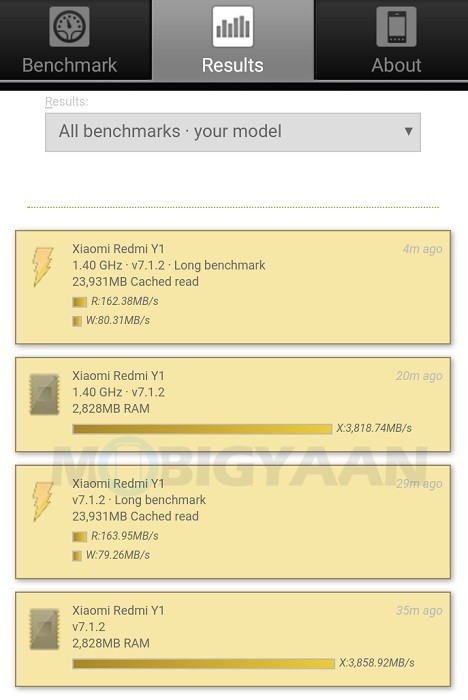
We also put the Redmi Y1 to test in Quadrant Standard Edition, and, it made a score of 15,454 points in that test. In our A1 SD Bench test, the RAM on the Y1 consistently came up with an average score of above 2800 MB/second.
Well, this was Redmi Y1’s performance in synthetic benchmarks, but, in real-world daily usage, we didn’t have much problems with the phone. App load times were decent and there weren’t much hiccups while navigating through the UI or switching between apps.
The phone also did well in gaming. We played games like N.O.V.A. 3: Freedom Edition, Traffic Rider and NFS No Limits, and, we don’t have much complaints about its gaming performance as well. The graphics rendered were also decent enough. Of course, there were some occasional stutters, but that’s something which can be dealt with by playing games on lower settings.
During normal gaming, the phone did remain cool, however, on playing multiple games back-to-back for a total duration of 1 hour, the phone did get warm. Well, that’s something you might notice on other phones too.
Games we tested on Xiaomi Redmi Y1
- N.O.V.A. 3: Freedom Edition
- NFS No Limits
- Traffic Rider
To sum it up, the Redmi Y1 did well in our day-to-day usage. It also handled most of the games we threw at it without much issues. If you are an occasional gamer and someone who relies on his smartphone only to use apps like WhatsApp, Facebook, Instagram and YouTube, then you may not have much complaints about the Redmi Y1’s performance.
Software
Let’s talk about the software on the Xiaomi Redmi Y1. The Redmi Y1 runs MIUI 9 based on Android 7.1.2 Nougat, however, the review unit we got runs MIUI Global 8.5.1 based on Android 7.1.2 Nougat. Of course, Xiaomi has already started rolling out the MIUI 9 update for the Y1, but surprisingly, we still haven’t received it on review unit yet.
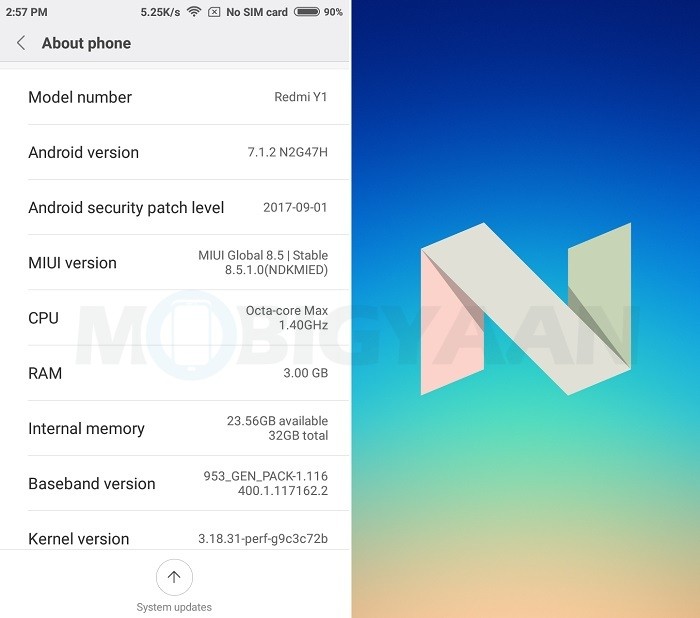
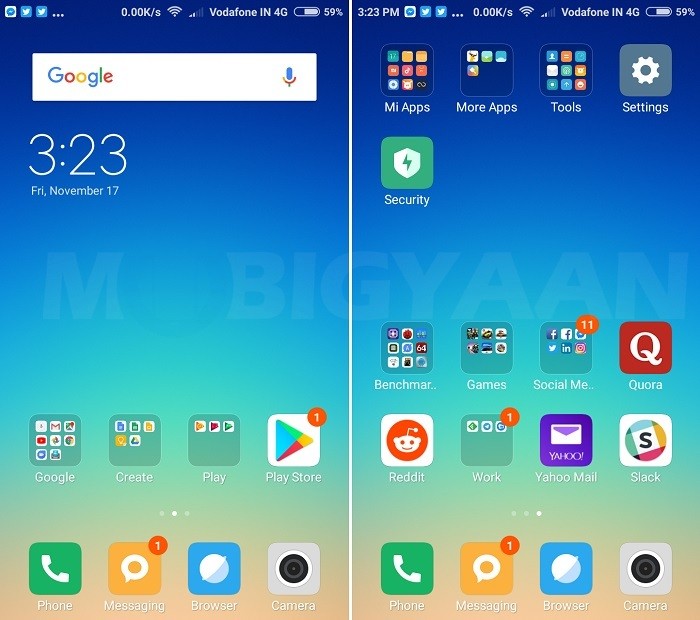
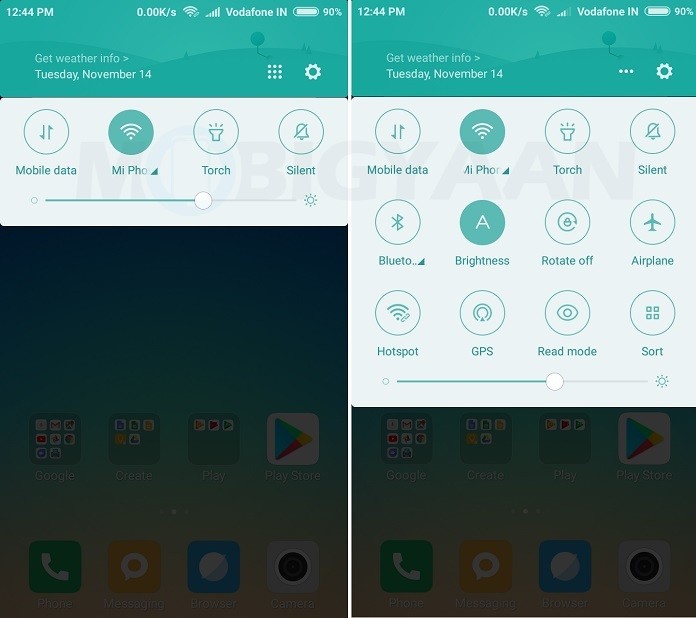
Well, anyways though, the MIUI 8.5 on the Redmi Y1 is similar to what you would see on other Xiaomi smartphones. The UI is still the same, all apps on the home screen and no app drawer. However, what’s good to see is that the Redmi Y1 doesn’t come with any bloatware, with the only third-party apps that came pre-installed being UC News and Amazon Shopping. However, these apps can be uninstalled easily if you don’t want them on their smartphone.
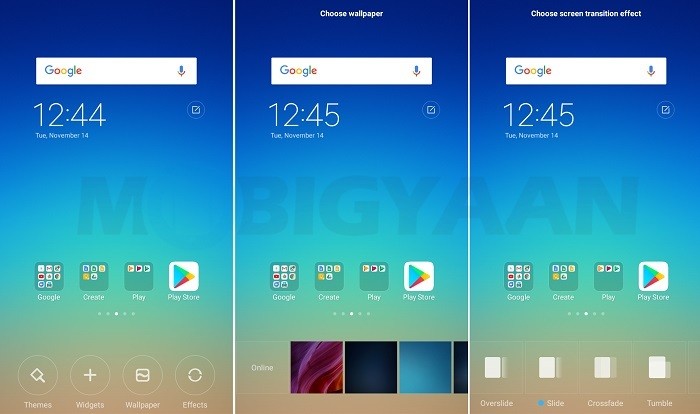
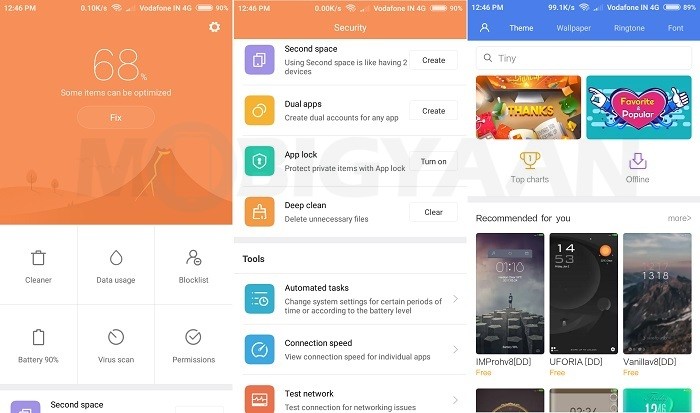
Like all other Xiaomi smartphones, the Redmi Y1 also comes with an app called Security which offers one place access to different settings related to data usage, battery, app permissions, app lock and more.
Other popular Xiaomi features like Second Space, Dual Apps and Quick Ball shortcuts are present as well on the Redmi Y1. Moreover, there’s also an app called Themes which lets you download different themes, wallpapers, fonts and ringtone to let you customize your phone.
There isn’t anything much to talk about the software on the Redmi Y1 as our review unit is currently on MIUI 8.5. However, once we receive the MIUI 9 update, we will try to update this software section.
Camera
The Xiaomi Redmi Y1 comes with a 13 MP camera at the back which has an aperture of f/2.2. However, the company has been advertising the Redmi Y1 as a selfie-centric smartphone, and hence, it has thrown in a 16 MP camera at the front which comes with a larger aperture as compared to rear camera and is also accompanied by flash to help you take brighter selfies in low-light conditions.


The 13 MP rear camera can take photos at a maximum resolution of 4160 x 3120 pixels, and, can record videos in a maximum resolution of 1920 x 1080 pixels. Speaking of the 16 MP front camera, the maximum resolution at which it can take photos and record videos is 4608 x 3456 pixels and 1920 x 1080 pixels respectively.
That was the UI of the Camera app of the Redmi Y1. There isn’t anything new here. Just the same UI we have seen on recent Xiaomi smartphones running MIUI. You get different filters, different scenes, beautify mode and everything that’s pretty standard on Xiaomi smartphones. The Redmi Y1 also comes with Manual Control which lets you adjust the ISO and White Balance.
For front camera, you get Beautify 3.0, which comes with two options – Smart and Pro – which let you adjust the Beauty Mode to help you take selfies to your liking.
Having said that, let’s take a look at the daylight shots taken from the Xiaomi Redmi Y1.
Click on any image above to enlarge it.
Now let’s take a look at the photos taken at night.
Click on any image above to enlarge it.
The photos taken from the rear camera in good lighting conditions turned out to be decent. Some photos did lack details, but, with the HDR Mode turned on, the photos turned out to brighter and sharp and came out with bit more detail. That said, some times, the photos taken with HDR Mode enabled turned out to be washed out and overblown.
Same is the case with photos taken in low-light conditions and at night. Moreover, if you are taking photos with HDR Mode turned on, you will have to keep your hand steady until the camera is done capturing the photo, otherwise, you will end up with a blurred image.
That said, let’s talk about that 16 MP camera on the front now which has been advertised a lot by Xiaomi. The selfies taken in good lighting conditions came out good. The Beauty Mode also helped take relatively better photos with the skin appearing bit smoother. However, when there were more than 1 person in the frame, the camera wasn’t able to focus properly.
The selfies taken in low-light were usable, but, the selfies that were taken without any proper lighting came up with a lot of noise. Also, the flash at the front didn’t turn out to be much useful either.
To sum it up. Both the rear and front cameras take decent photos in good lighting conditions. However, low-light performance isn’t something we are much impressed of.
Call Quality, Audio and Storage
The call quality on the Xiaomi Redmi Y1 was decent. We didn’t have any issues listening to the other person on the call, and, neither did that other person have any issues hearing us. While the phone did manage to latch on to the 4G network pretty well, in areas with lower signal reception, the phone kept loosing network and kept flashing “Emergency calls only”. But again, that’s something I have witnessed on many other smartphones I reviewed recently. However, the only difference is that the frequency of loosing network was a bit more on the Redmi Y1.

The Xiaomi Redmi Y1 comes with a single speaker at the bottom. Well, this kind of placement ensures that the audio coming off the speaker doesn’t get muffled when the phone is kept lying on a flat surface. However, with this kind of speaker placement, the audio does get blocked when you are playing games or watching videos.
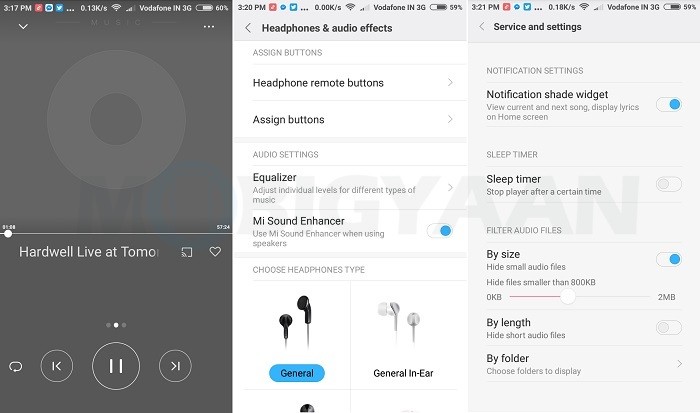
The speaker itself is fine enough though, but, don’t expect it to be loud enough to be used a substitute to your Bluetooth speaker at a party.
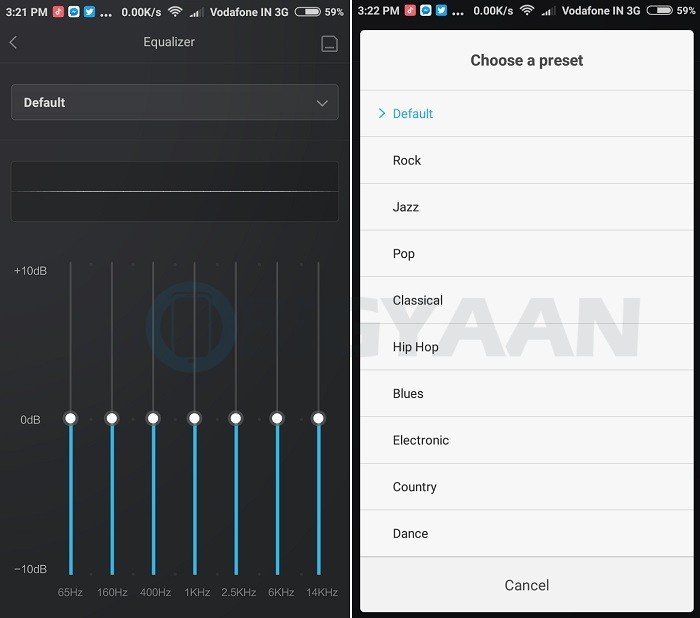
The Xiaomi Redmi Y1 comes with a Music app, and, it isn’t anything different from the Music apps you would see on other Xiaomi smartphones. You get an Equalizer to adjust the output of the audio by either switching between available presets, or, customizing them to your liking.
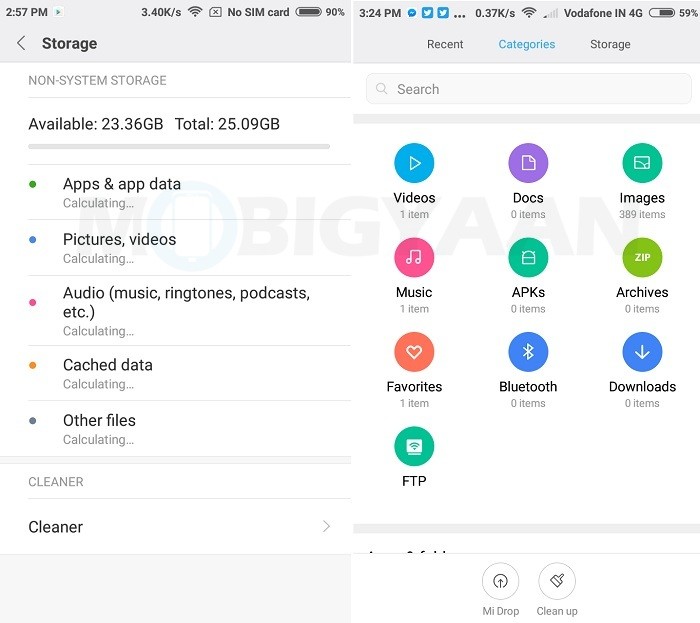
Like we already said, the Xiaomi Redmi Y1 comes in two models – 3 GB RAM + 32 GB storage and 4 GB RAM + 64 GB storage. Our review unit came with 3 GB RAM and 32 GB storage, and, the storage available to the user on the 32 GB variant is 25 GB. However, you do have an option to expand the storage up to 128 GB via microSD card.
That said, the Redmi Y1 also comes with a file manager app called Explorer which lets you browse through your phone’s storage. It also categorizes different files based on their types so that you can find them quickly.
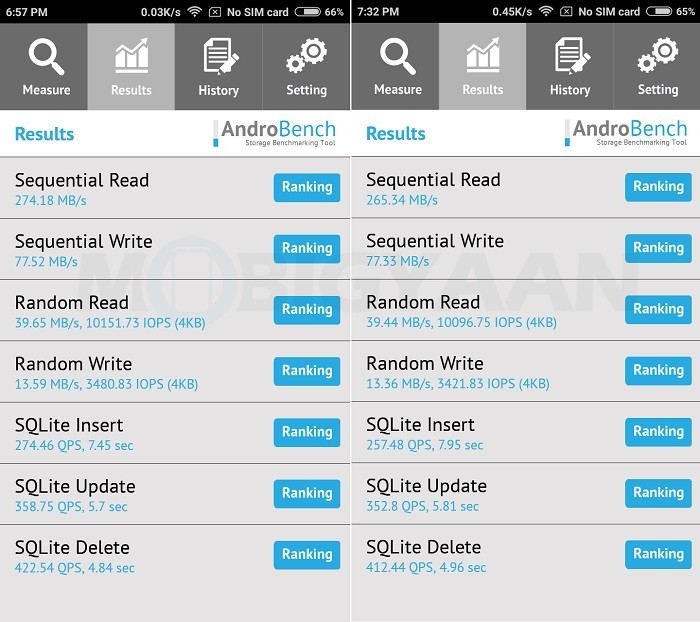
We also put the Redmi Y1’s storage to test, and, the results aren’t all that enticing. In our AndroBench test, the Redmi Y1 came up with an average Sequential Read score of around 270 MB/second, and, in Sequential Write, the phone came up with an average score of around 77 MB/second. Well, this isn’t a flagship after all, so you shouldn’t be expecting much out of it.
Battery
The Xiaomi Redmi Y1 ships with a 3080 mAh non-removable battery, which, when compared to Redmi 4, is 1020 mAh smaller.
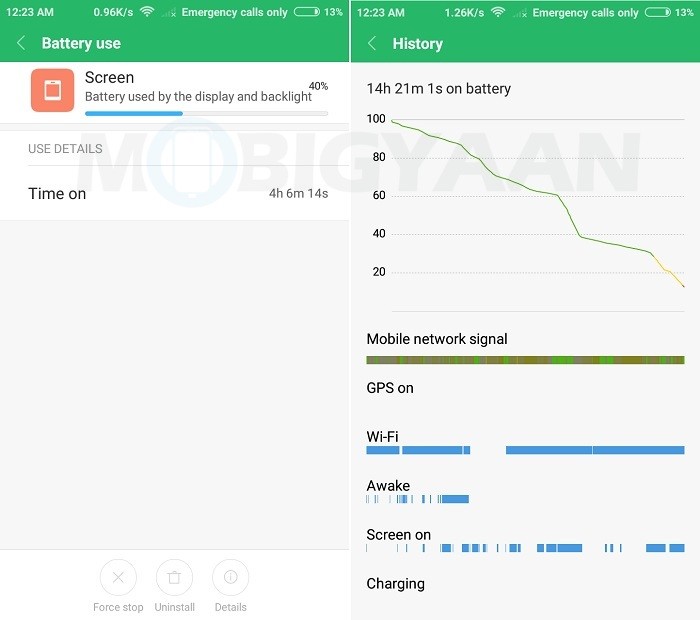
The battery life on the Xiaomi Redmi Y1 is decent enough. On heavy usage, we got a screen-on-time of 4 hours on an average with still around 10% battery left to be used. However, on normal usage, the battery easily lasted us for a day, and sometimes, for more than that. Take a look at the battery table below which depicts our usage through which we got 4 hours of screen-on-time on an average.
[table id=122 responsive=flip/]
Having said that, let us tell you that we were always connected to Wi-Fi network. If you are someone who relies on Mobile Data instead of a Wi-Fi network, the battery backup you get would be relatively less.
Moreover, the Xiaomi Redmi Y1 doesn’t support quick charging, and, with the bundled 10W power adapter, it took somewhere around two hours on an average for the battery to fully charge.
Pricing, Variants and Availability
The Xiaomi Redmi Y1 comes in two different models:
- 3 GB RAM + 32 GB internal storage
- 4 GB RAM + 64 GB internal storage
The 3 GB RAM variant is priced at ₹8999 whereas the 4 GB RAM variant comes with a price tag of ₹10,999. The Redmi Y1 is also offered in two colors – Gold and Dark Grey.
The Xiaomi Redmi Y1 is available for purchase on Amazon India and Mi.com. The next sale is scheduled at 12 pm on November 22. It is also sold through offline stores like Xiaomi’s Mi Home and other Mi preferred partners like Big Bazaar, Reliance Digital, Croma and more.
Should you buy the Xiaomi Redmi Y1?
The Xiaomi Redmi Y1 is a decent smartphone and offers good value for money. It is powered by Snapdragon 435 SoC that’s paired with 3 or 4 GB RAM. The performance of the Redmi Y1 was decent and there weren’t much hiccups.
The 5.5-inch HD display is also good enough. Besides, with the Redmi Y1, you also get MIUI 9 which is the latest version of Xiaomi’s custom Android skin. The battery backup is also decent and it should last you a day with ease on normal to moderate usage.
Speaking about photography, the rear and front camera both get the job done decently in good lighting conditions, however, the low-light performance is something we would have loved to be better.
All in all, the Xiaomi Redmi Y1 is essentially the Redmi 4, but with smaller screen, smaller battery, more RAM and better front camera.
The Redmi Y1, like other Xiaomi smartphones in this segment, offers good value for money. However, with Redmi Y1, Xiaomi is now aiming at those who want an affordable and decent smartphone that can take good selfies.
Having said that, the Redmi Y1 can turn out to be another bestseller for Xiaomi in India, and, if you are someone who takes a lot of selfies and wants an affordable smartphone with decent hardware, then the Xiaomi Redmi Y1 is worth considering. However, if you can let go of that 16 MP front camera, then Xiaomi’s Redmi 4 and Redmi Note 4 are also worth considering.
Other options:
- Xiaomi Redmi 4 (3 GB RAM + 32 GB storage – ₹8999 | 4 GB RAM + 64 GB storage – ₹10,999)
- Xiaomi Redmi Note 4 (3 GB RAM + 32 GB storage – ₹9999 | 4 GB RAM + 64 GB storage – ₹11,999)
Pros
- Lightweight
- Performance
- Battery
- Fingerprint Scanner
- Dedicated slot for microSD card
Cons
- Low-light camera performance










